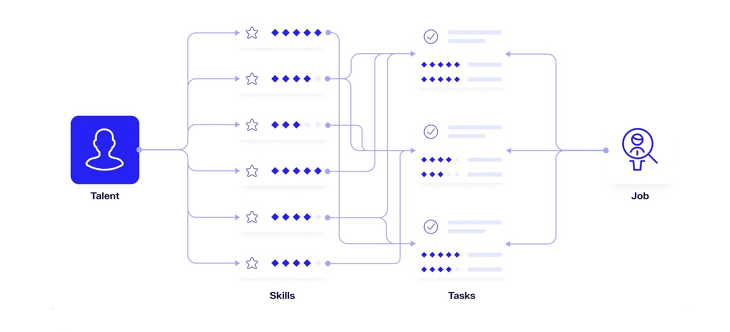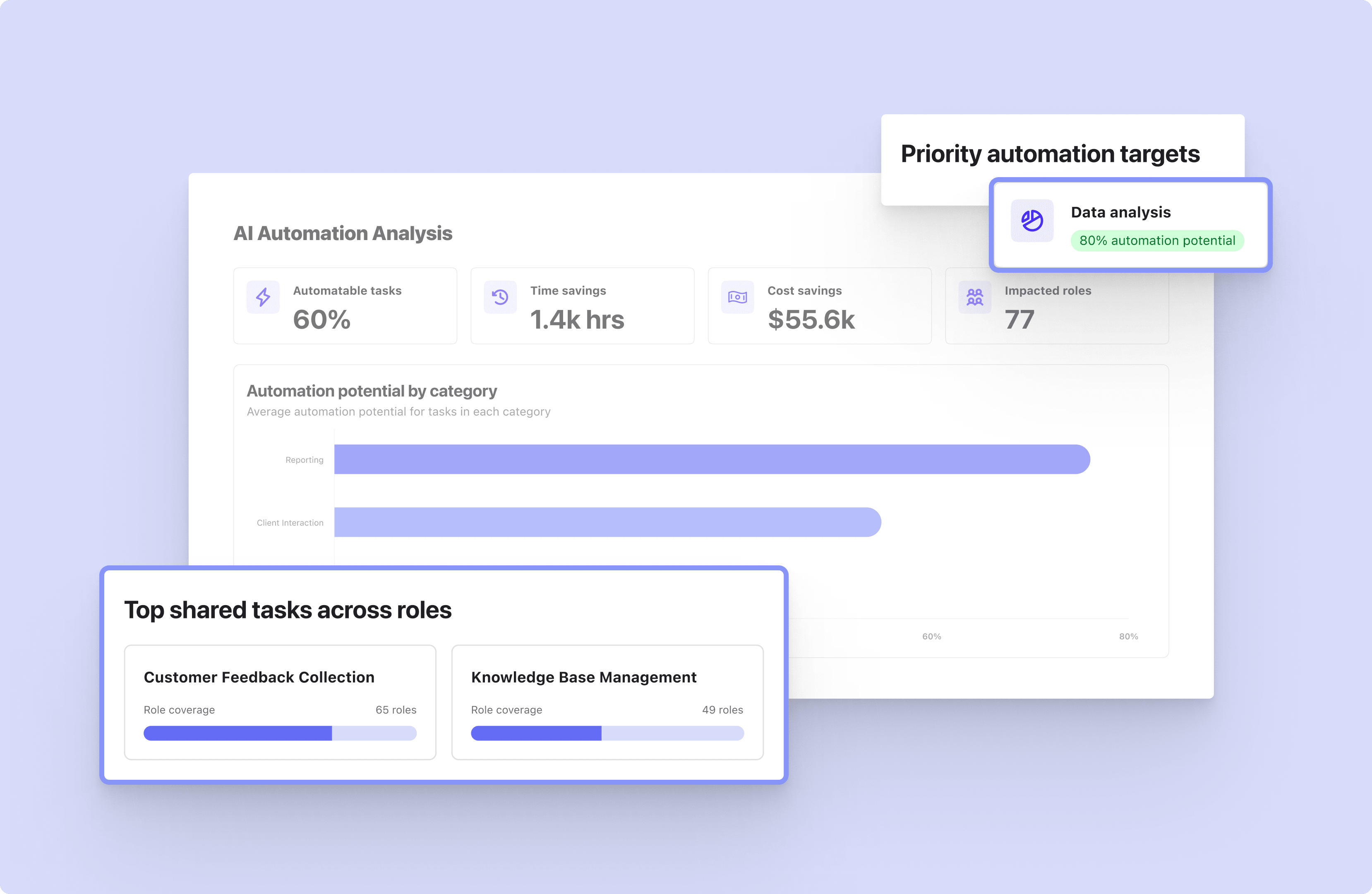What Is Task Intelligence? A Smarter Way To Understand Work
As businesses face increasing pressure to improve productivity, reduce costs, and adapt to AI, one question is becoming more urgent: Do you really know how work is getting done in your organization?
You may know how many people you have, their roles, their skills, and even information relating to their performance. But do you know what tasks they’re doing, how often they do them, and how much value that work creates?
Moreover, how do you model “work” in an age where it’s not only humans contributing to the success of your organization?
That’s where task intelligence comes in.
What Is Task Intelligence?
Task intelligence is the practice of capturing and analyzing data about the specific tasks employees perform, and the “units of work” required within every role at your company. It goes beyond job titles or hours worked to reveal the actual nature of daily work: the activities people spend time on, how often those tasks are repeated – and even what those units of work cost to produce.
Think of it as an X-ray of your workforce operations. While traditional workforce analytics tell you who is doing the work, task intelligence explains more of the “what”: the tasks being done (or not), how much time (and people expense) is involved, and where there are critical gaps … or overlaps.

Skills data tell us what people are capable of, but this is limiting. In a world where AI agents perform specific functions – but do not take on entire jobs – you need to model workforce plans using task-level data. This is the best way to determine which tasks are ideal for automation – and which types of work people are uniquely positioned to deliver.
Eighty one per cent of leaders say they expect agents to be moderately or extensively integrated into their company’s AI strategy in the next 12–18 months. – Microsoft Work Trend Index Annual Report 2025
Tasks reveal how work actually flows through an organization: how often it happens, how much effort it takes, where duplications occur, and what’s ripe for automation. They provide the operational context that skills alone can’t.
And it’s becoming easier than ever to visualize task intelligence. Thanks to AI, companies are now able to generate task-level insights, enabling them to:
- See clearly how work flows through teams and departments
- Identify quickly which tasks are best suited for automation or redeployment
- Simulate how workforce changes affect operational capabilities and costs (think of use cases like M&A, reorganization, or modeling a global expansion plan)
- Align talent strategies precisely with business needs, at a granular level
Tasks deliver outputs and skills enable execution. Without understanding both, it’s hard to make good decisions about where to invest, who to redeploy or reskill, and how to build a more efficient, future-ready workforce.
Why Task Intelligence Matters For Businesses Today
This new way of looking at work is particularly crucial in the era of AI. As agents and other AI-powered tools can take on some of the tasks previously done by people – but rarely an entire role – a task-based view gives you the correct level of granularity. Where can AI best support your employees?
It’s also worth noting that today’s workforce is under strain. According to Microsoft, 53% of leaders say productivity must increase, yet 80% of employees feel they lack the time or energy to do their best work. Meanwhile, business leaders report spending 41% of their time on work that doesn’t directly contribute to business value (Deloitte).
These numbers highlight a growing disconnect: employees are busy, but not always productive. And companies are struggling to spot where time, money, and energy are being wasted.
Task intelligence helps close that gap. By revealing exactly how time is spent, it enables leaders to:
- Identify duplication and inefficiencies
- Prioritize which tasks to automate or redesign
- Redeploy and reskill employees where needed to higher-impact work
- Improve workforce productivity without cutting headcount
How Does Task Intelligence Work?
Task intelligence works by breaking down job roles into the specific actions and processes they involve. This might include:
- Responding to emails or support tickets
- Entering or reconciling data
- Running reports or pulling analytics
- Drafting content, designing visuals, or developing campaign strategies
With the right AI-powered tools, this data can be captured passively by analyzing the resumes, job descriptions, and work outputs already circulating across your systems – from ATS and HRIS platforms to project management tools and performance reviews. AI maps this unstructured information to a consistent skills and task taxonomy, identifying patterns in how work is actually done.
This intelligence is then structured into dynamic job architectures and surfaced through a workforce intelligence layer that integrates with the rest of your HR tech stack: powering smarter planning, matching, and workforce decisions.
The key is making work visible, measurable, and actionable.
What Are The Benefits Of Task Intelligence?
1. Better Workforce Visibility
You gain a real-time view into how people are spending their time and what it is producing, not just what’s written in job descriptions.
2. Smarter Decisions About Automation
By identifying which tasks are repetitive or low-value, you can make informed choices about where AI can best augment your workforce – reducing manual effort and lowering operational costs.
3. Improved Talent Allocation
Free up your experts from routine work and redeploy them to higher-impact projects: closing process gaps, accelerating delivery, and contributing more directly to business growth and profitability.
4. Fewer Silos & Redundant Workflows
For example, if both Finance and Sales teams are producing overlapping reports, task intelligence will flag it – helping you streamline processes, eliminate duplication, and reduce unnecessary spend.
5. A Foundation For AI Strategy
As more companies introduce AI agents, knowing which tasks are best handled by people vs. machines becomes critical. In fact, 81% of leaders expect AI agents to be integrated into their strategy in the next 12–18 months, and 82% expect digital labor to expand workforce capacity. (Microsoft)
Who Should Use Task Intelligence?
Task intelligence isn’t just for the HR and People teams who can use it to redesign jobs and support skills-based talent planning.
It’s relevant for:
- COOs and line of business leaders who are looking to streamline processes, reduce waste, and ensure the workforce is focused where it matters most
- CFOs and Finance leaders who want to link labor investment to actual value creation
- Digital transformation teams who need to identify bottlenecks and opportunities for automation
- IT and AI leaders who are keen to understand how digital labor impacts real workflows
No matter your function, if you’re responsible for workforce productivity, task intelligence gives you the visibility you need to take action.
How Task Intelligence Supports a Skills-Based Approach
When paired with skills intelligence – a view into what people can do – task intelligence becomes even more powerful.
Together, they allow you to:
- Match people to tasks they’re uniquely qualified for
- Predict future workforce needs based on actual work patterns
- Identify gaps between current capabilities and evolving business demands
- Identify risks to execution based on talent availability, both within and outside of your organization
- Support reskilling, internal mobility, and better job design
It’s a more dynamic, data-driven approach to workforce strategy … essential for thriving in a world shaped by AI and constant change.

How Beamery Supports Task Intelligence
Beamery’s AI-powered platform helps organizations understand both what work is being done and who is best suited to do it. It brings together your internal data – from employees, roles, and workflows – with external labor market insights to generate contextual, dynamic workforce intelligence built on a shared language of skills and tasks.
The result is a ‘digital twin’ of your workforce, informed by both internal and external data, that enables business leaders to model different planning scenarios, anticipate talent risks, and make confident, forward-looking decisions.
With Beamery, you can:
- Capture and analyze real-time task data across operational teams
- Surface inefficiencies and duplicated efforts
- Pinpoint high-effort, high-frequency tasks that could be automated
- Calculate time and cost savings before taking any action
- Model various workforce scenarios – and their time and cost savings impacts – with precision and ease
- Redesign roles based on live skills and task patterns
- Make smarter decisions about automation, hiring, and workforce development
By connecting task-level insights with skills and business goals, Beamery helps you translate workforce intelligence into actionable plans tied directly to business outcomes.
Why Task Intelligence Is The Future of Workforce Optimization
As organizations navigate AI adoption, economic pressure, and shifting employee expectations, one thing is clear: you can’t optimize what you can’t see.
Task intelligence brings much-needed transparency to how work happens. It enables leaders to move beyond assumptions and take control of workforce strategy, with the precision and clarity today’s business environment demands.
Keen to see it in action? Watch our recent webinar on demand, where we showcase Task Intelligence in Action: Workforce Planning Powered by AI.
Whether you’re planning for automation, rethinking job design, or looking to drive real productivity gains, task intelligence is the key to making smarter, faster, more informed workforce decisions.